Weather Wiz Kids -What is a Tornado?

Sky Diary KIDSTORM -facts about tornadoes
A tornado isn't likely to take you to Munchkinland, as it did in "The Wizard of Oz," but a strong one can destroy buildings and create a damage path more than a mile wide. Its wind speeds can top 300 miles per hour. Tornadoes occur just about everywhere in the world, from India to Australia, and all over the United States, but the most famous and active breeding ground for tornadoes is Tornado Alley. We don't know all the reasons a tornado forms, but scientists have a general idea of the weather ingredients that need to come together. Tornadoes can form out of many kinds of storms, but the type most likely to produce tornadoes is the supercell. Under the rain-free base of a supercell, look for a wall cloud to form. Big hail is another danger posed by supercells and other storms. A tornado is only a tornado if it's in contact with the ground. Most tornadoes last only 5 or 10 minutes, but some have been known to last more than an hour. The theoretical scale conceived by the late Dr.
Pitara Kids Network -Discover Tornados
Pitara Kids Home > Discover > Earth facts for kids Compiled by Bindu Misra; Illustrations by Amarjeet Malik Popularly known as twisters, tornado is derived from Spanish word ‘Tronada’ meaning thunderstorm and ‘Tornar’ meaning to turn. A tornado is defined as a violently rotating column of air that can spin faster than 300 m.p.h., extending from a thunderstorm to the ground. Tornadoes generally exhibit a certain characteristic cycle of behaviour between formation and final disappearance. Tornadoes occasionally accompany tropical storms and hurricanes that move over land. An area of rotation, 2-6 miles wide, now extends through much of the storm. Tornadoes take many shapes and sizes. It is commonly believed that areas near rivers, lakes and mountains are safe from tornadoes. Trivia about tornadoes Although tornadoes form all over the world, they are more frequent and stronger in US. A tornado that forms over warm water is called a waterspout. Neither are strong tornadoes.
Wikipedia: Tornado
A tornado is a violently rotating column of air that is in contact with both the surface of the earth and a cumulonimbus cloud or, in rare cases, the base of a cumulus cloud. They are often referred to as twisters or cyclones,[1] although the word cyclone is used in meteorology, in a wider sense, to name any closed low pressure circulation. Tornadoes come in many shapes and sizes, but they are typically in the form of a visible condensation funnel, whose narrow end touches the earth and is often encircled by a cloud of debris and dust. Most tornadoes have wind speeds less than 110 miles per hour (177 km/h), are about 250 feet (76 m) across, and travel a few miles (several kilometers) before dissipating. Various types of tornadoes include the landspout, multiple vortex tornado, and waterspout. Tornadoes have been observed on every continent except Antarctica. There are several scales for rating the strength of tornadoes. Etymology Definitions Funnel cloud Outbreaks and families Appearance
Related:
Related:



